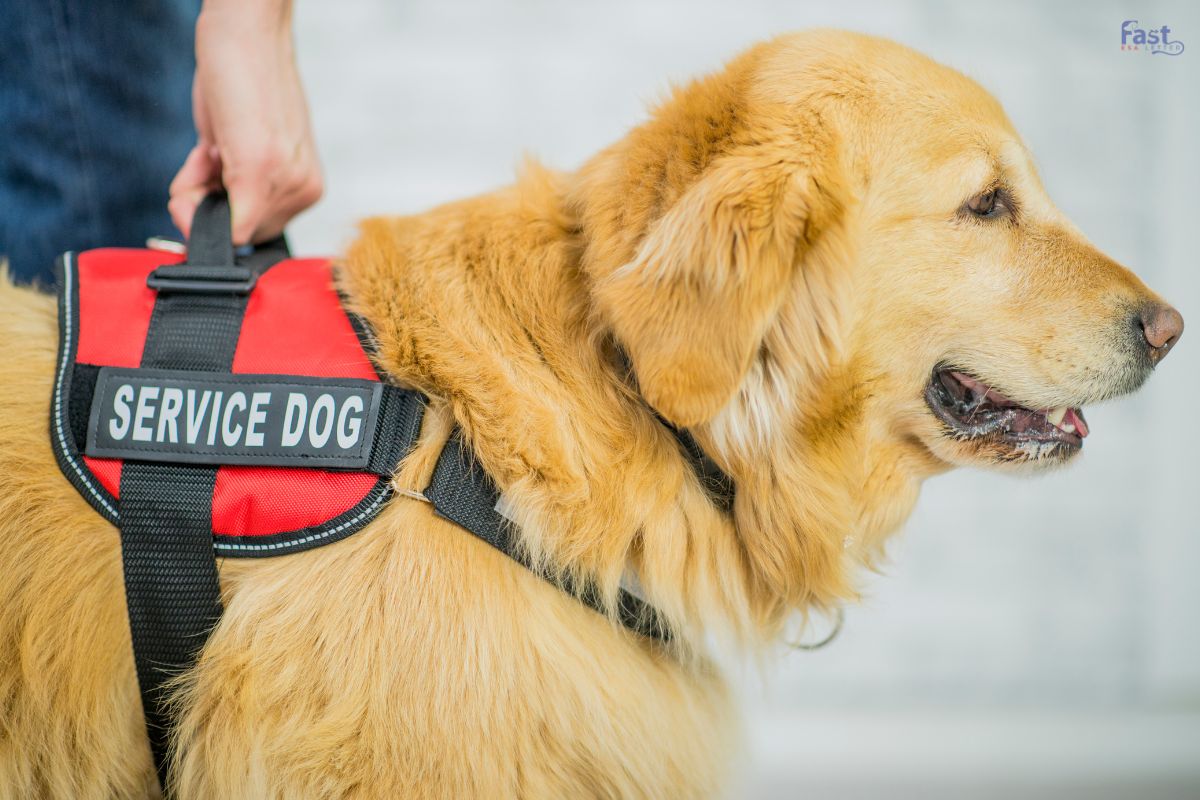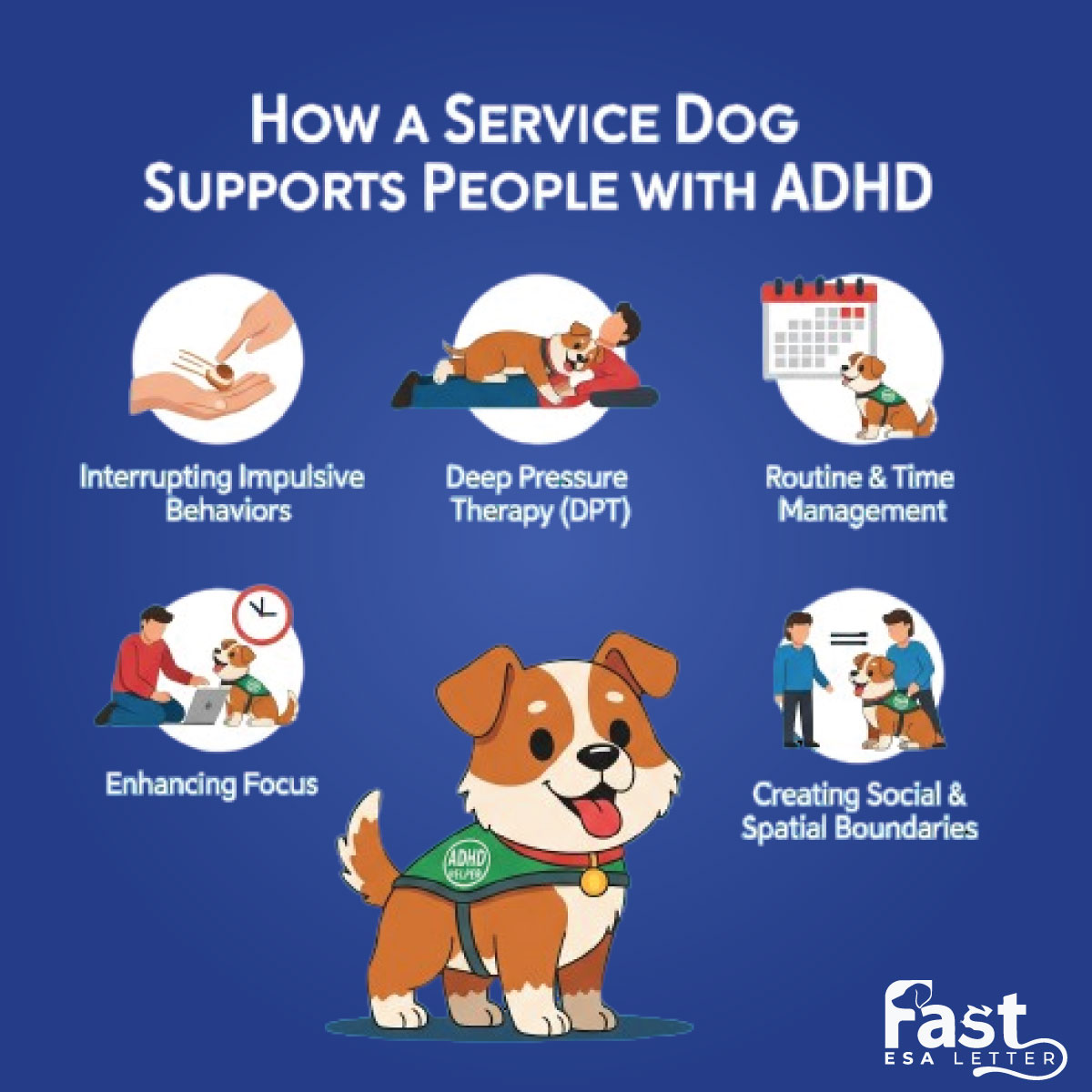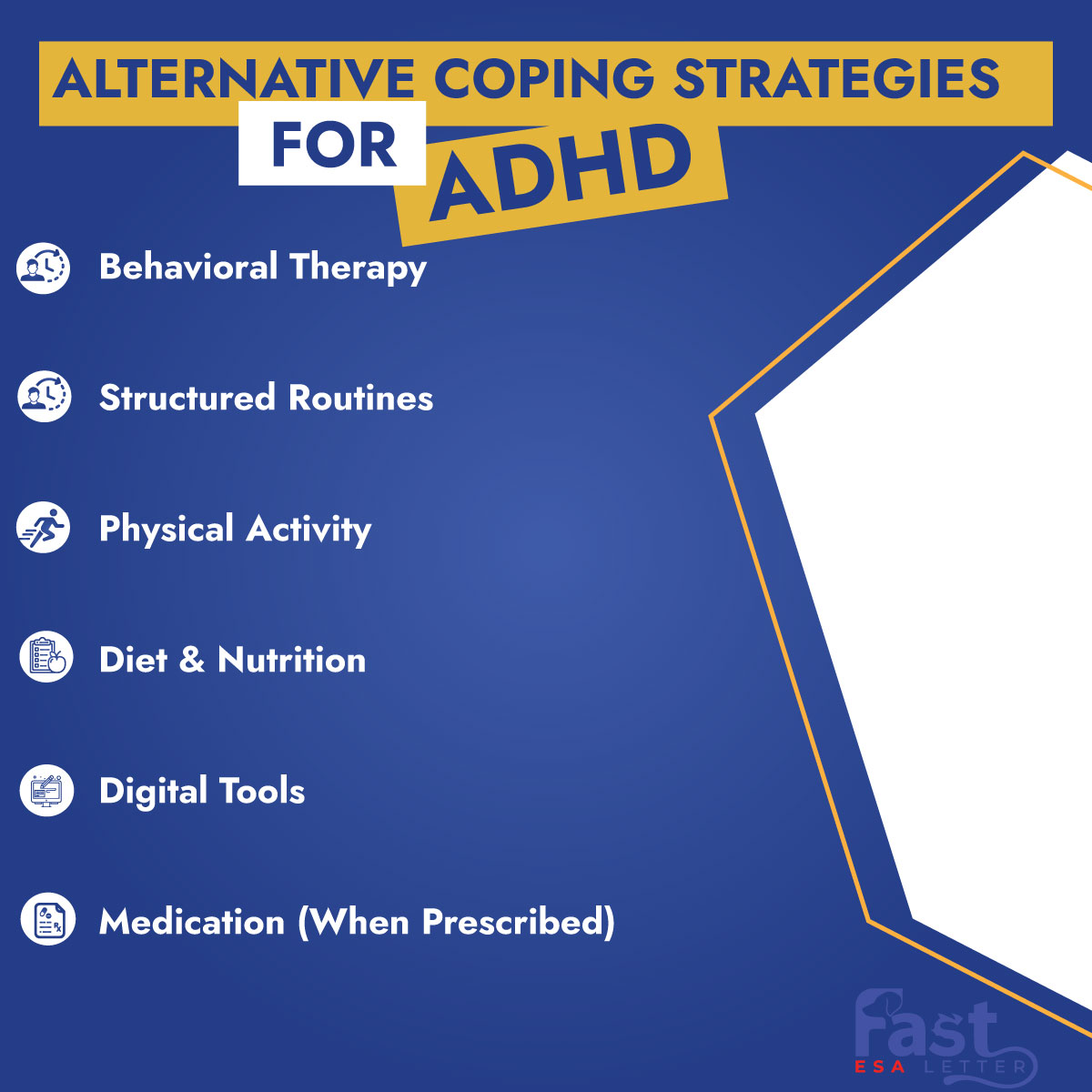How to Get a Service Dog for ADHD in 2025?

Robert Clendenin, MD
ADHD can disrupt focus, emotional regulation, task management, and relationships. While treatments like behavioral therapy and medication are widely used, they don’t work for everyone. As a result, many are now exploring alternative support options—such as service dogs for ADHD—to better manage their symptoms and daily routines.
Far beyond affectionate companions, service dogs for ADHD are trained working animals that assist with daily challenges through task-specific support.
Let’s dive into how these dogs help manage ADHD, what tasks they perform, and how you can get one, from eligibility to cost and legal rights.

What Is ADHD?
How Psychiatric Service Dogs Help with ADHD Symptoms?
A Psychiatric Service Dog for ADHD is more than a comforting presence—they’re trained to perform specific, task-based interventions that address core ADHD challenges like executive dysfunction, emotional dysregulation, and sensory overstimulation. Each task is tailored to the individual’s unique symptoms and daily routine.
Here Are Some Key Ways A Service Dog For Adhd Can Support Their Handler
- Interrupting Impulsive Behaviors
Individuals with ADHD often act on impulses without fully processing consequences. A PSD is trained to recognize behavioral cues—such as pacing, fidgeting, or agitation—and gently interrupt these patterns through touch, nudging, or barking. This helps redirect attention and prevent impulsive decisions or potentially risky actions.
- Providing Deep Pressure Therapy (DPT)
During episodes of anxiety, hyperactivity, or sensory overload, the PSD may apply deep pressure therapy by lying across the handler’s lap or chest. This firm, grounding pressure has been shown to activate the parasympathetic nervous system, promoting a calming effect and reducing physiological stress.
- Assisting with Routine and Time Management
Maintaining structure can be challenging for individuals with ADHD. Service dogs can be trained to perform task reminders—nudging at medication times, prompting their handler to move to the next activity, or waking them up with gentle stimulation. This helps promote independence and reduces reliance on external supervision or alarms.
- Enhancing Focus and Redirecting Attention
Whether in a classroom, workplace, or crowded public space, distractions are constant. A PSD can gently bring their handler’s focus back to the task at hand through nudges, eye contact, or guided movement. This redirection is especially helpful during episodes of mental drift or executive dysfunction.
- Creating Social and Spatial Boundaries
In overwhelming environments or social settings, a PSD can act as a physical barrier, standing between the handler and others. This not only provides a sense of safety but also helps minimize overstimulation. For children and adults who feel anxious in crowds, the dog’s presence acts as both a sensory anchor and social shield.

Can You Get a Service Dog for ADHD?
- Have a documented diagnosis of ADHD that significantly limits one or more major life activities, such as learning, working, or social interaction.
- Experience functional limitations due to ADHD symptoms, such as chronic disorganization, impaired emotional regulation, or executive dysfunction, that a trained dog can help mitigate.
- Obtain a recommendation or evaluation from a licensed mental health professional or physician who confirms that a service dog is a necessary part of your treatment plan.
It’s also important to differentiate this from emotional support animals (ESAs). While ESAs can be helpful for individuals with ADHD, they do not have the same public access rights or task-specific training required of a psychiatric service dog.
How To Get a Service Dog for ADHD?
1. Choose and Train Your Service Dog
Before seeking a PSD letter, you’ll need to identify a dog that can be trained—or is already trained—to assist with ADHD-related tasks. You have two options:
- Program-Trained Service Dog: Apply to an organization that professionally trains service dogs for psychiatric conditions like ADHD.
- Owner/Handler Training: Train your own dog, either independently or with a certified trainer. The ADA allows self-training as long as the dog reliably performs at least one disability-mitigating task.
The dog should be trained for tasks such as interrupting impulsive behavior, helping with transitions, offering grounding during overstimulation, and maintaining composure in public.
2. Schedule an Online Consultation
3. Speak with a Licensed Mental Health Professional
4. Receive Your PSD Recommendation Letter
- Is this dog a service animal required because of a disability?
- What work or task has the dog been trained to perform?
Carrying your PSD letter or a voluntary ID badge may reduce friction in public but is not a legal requirement.
How Much Does It Cost to Get a Service Dog for ADHD?
The cost of getting a service dog for ADHD varies widely based on the training route and provider:
- Professionally Trained Service Dog: $15,000–$40,000+
This includes ADHD-specific task training, public access readiness, and post-placement support. Nonprofits may offer low-cost or subsidized options, but expect long wait times.
- Owner-Trained or Self-Trained Dog: $2,000–$10,000
If you train your own dog, expenses include private training sessions, behavioral assessments, and public access courses. It’s more affordable but requires significant time and consistency.
- Ongoing Annual Costs: $1,000–$2,500
Includes veterinary care, food, grooming, training refreshers, and gear.
What Are the Best Service Dog Breeds for ADHD?

- Labrador Retriever
- Golden Retriever
- Standard Poodle
- Cocker Spaniels
- Miniature Schnauzer (for small-dog preference)
- German Shepherd
- Border Collie
- Boxer
Alternative Coping Strategies for ADHD

- Behavioral Therapy: Cognitive Behavioral Therapy (CBT) helps address impulsivity, time management, and negative thinking patterns often associated with attention deficit disorder.
- Structured Routines: Using planners, digital reminders, or visual schedules can enhance executive functioning and reduce forgetfulness or disorganization.
- Physical Activity: Regular exercise, especially aerobic activity, has been shown to improve concentration, mood regulation, and sleep in individuals with ADHD.
- Diet & Nutrition: Balanced meals rich in omega-3 fatty acids, protein, and complex carbs may support better focus and mood stability.
- Digital Tools: Apps for task management, mindfulness, or habit tracking can offer real-time support in managing daily responsibilities.
- Medication (When Prescribed): Stimulant and non-stimulant medications remain a frontline treatment and may be combined with other strategies for optimal results.
These tools can be used individually or alongside a psychiatric service dog to create a well-rounded support system tailored to each person’s needs.
Conclusion
For many, these dogs become more than trained aides; they’re trusted partners in creating a more stable and empowered life. If you or a loved one is exploring new ways to manage ADHD, take the time to learn more about psychiatric service dogs, and take the first step toward a more supported future.
Frequently Asked Questions (FAQs)
Can You Train Your Own Dog to Be a Service Dog for ADHD?
Yes. Under ADA guidelines, you can train your own service dog for ADHD, as long as the dog is housebroken, under control, and trained to perform at least one task that helps manage your ADHD symptoms. Just ensure the dog meets all legal standards to qualify as a psychiatric service dog.
Do Children With ADHD Qualify For A Service Dog At School?
Are There Breed Restrictions For Psychiatric Service Dogs?
How Long Does It Take To Train A Service Dog For ADHD?
How Long Does It Take To Train A Service Dog For Anxiety?
Are Service Dogs For ADHD Allowed On Airplanes In 2025?
Yes. Under the Air Carrier Access Act (ACAA), psychiatric service dogs are permitted to fly in the cabin with their handler, provided documentation or behavior-based criteria are met.
Can A Rescue Dog Be Trained To Become A Service Dog For ADHD?
Is A Small Dog Effective As A Psychiatric Service Dog For ADHD?
Can I Take My ADHD Service Dog Into Restaurants And Stores?
What Is The Best Service Dog Breed For ADHD In Small Apartments Or Urban Homes?
What Qualities Make A Dog Suitable For ADHD Support?
The best service dogs for ADHD are trainable, emotionally stable, responsive, and low-reactive in high-stimulus environments. They must be capable of learning psychiatric tasks such as interrupting impulsive behaviors, providing deep pressure therapy, or assisting with time management.
Do I Need To Register My ADHD Service Dog Or Get A Vest And ID?
No official registration or certification is required under the ADA. However, using an ID card or vest is optional and may help reduce public confusion. Your dog must be trained for at least one disability-related task and remain under control in public.
Post Author
Prince Sharma
Related Articles
No Results Found
The page you requested could not be found. Try refining your search, or use the navigation above to locate the post.
Live Free with Your ESA!
An ESA Letter Unlocks Freedom!


